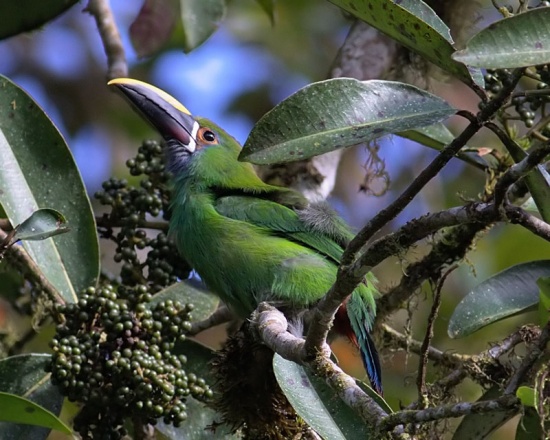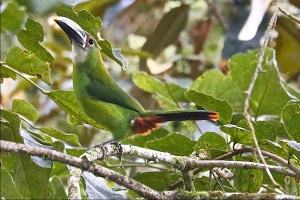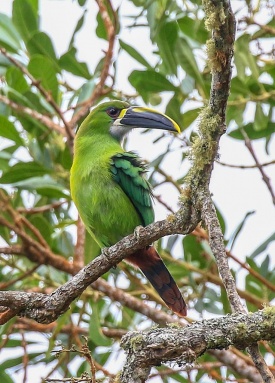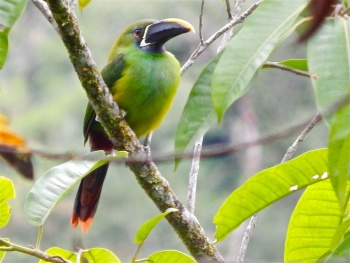| Line 53: | Line 53: | ||
Breeding generally from March to July, locally starting in February and lasting to November. They nest in an unlined cavity in a tree; 3-4 white eggs are laid and incubated by both sexes for 14–15 days. Both parents care for the young which fledge after about 6 weeks. | Breeding generally from March to July, locally starting in February and lasting to November. They nest in an unlined cavity in a tree; 3-4 white eggs are laid and incubated by both sexes for 14–15 days. Both parents care for the young which fledge after about 6 weeks. | ||
==References== | ==References== | ||
| − | #{{Ref-HBWVol7}}#{{Ref-Clements6thAug17}}#{{Ref- | + | #{{Ref-HBWVol7}}#{{Ref-Clements6thAug17}}#{{Ref-GillDonsker17V7.3}}#HBWalive read April 2018 |
{{ref}} | {{ref}} | ||
| + | |||
==External Links== | ==External Links== | ||
{{GSearch|Aulacorhynchus+albivitta}} | {{GSearch|Aulacorhynchus+albivitta}} | ||
[[Category:Birds]] [[Category:Aulacorhynchus]] | [[Category:Birds]] [[Category:Aulacorhynchus]] | ||
Revision as of 02:57, 29 April 2018
- Aulacorhynchus albivitta
Includes: Andean Toucanet; Black-throated Toucanet; Black-billed Toucanet; Greyish-throated Toucanet; White-throated Toucanet; Santa Marta Toucanet
Identification
30-35cm (11¾-13¾ in). Sexes similar but females have shorter bills.
- Green plumage
- Rufous vent and tail tip
- Black bill with yellow on the upper mandible
- White, black or blue throat dependent on subspecies
- Eye ring can be blue to red
- Dull grey legs
- Dark iris
Variations
The subspecies vary in colour of basal line of bill, throat colour, tone of green around breast and head and extent of black on bill:
- lautus has grey throat becoming bluish at edge with green plumage
- griseigularis with grey throat
- albivitta with white throat, white basal bill lne and a lot of blue around the eye
- phaeolaemus with blue-grey throat
- cyanolaemus with blue throat and almost all black bill
- atrogularis with black throat
- dimidiatus with black throat, also smallest subspecies
Distribution
Found from Colombia and western Venezuela to Ecuador, Peru, Bolivia and western Brazil. On the eastern slope of Andes and associated lowlands except for Colombia where also found on Central Andes and even reaching the northern end of Western Andes.
Locally common in parts of its range.
Taxonomy
Formerly considered conspecific with Northern Emerald Toucanet under the name Emerald Toucanet. Gill and Donsker further split this species into White-throated Toucanet (lautus, griseigularis, albivitta and phaeolaemus) and Black-throated Toucanet. HBWalive recognize three species, using Greyish-throated for the first four subspecies, Black-billed for cyanolaemus and Black-throated for the remaining two.
Subspecies
Clements recognizes 7 subspecies in four groups[2]:
- Santa Marta Toucanet:
- A. a. lautus - Santa Marta Mountains in north east Colombia
- Gray-throated Toucanet
- A. a. griseigularis - northern end of West Andes and western slope of Central Andes of Colombia
- Andean Toucanet
- Black-throated Toucanet:
Habitat
Open woodland and humid forest. Locally up to 3700m.
Behaviour
Diet
Their diet consists mostly of fruit, but some insects, lizards, and bird eggs are also taken. Forages usually singly, sometimes in groups.
Breeding
Breeding generally from March to July, locally starting in February and lasting to November. They nest in an unlined cavity in a tree; 3-4 white eggs are laid and incubated by both sexes for 14–15 days. Both parents care for the young which fledge after about 6 weeks.
References
- Del Hoyo, J, A Elliot, and J Sargatal, eds. 2002. Handbook of the Birds of the World. Volume 7: Jacamars to Woodpeckers. Barcelona: Lynx Edicions. ISBN 978-8487334375
- Clements, J. F., T. S. Schulenberg, M. J. Iliff, D. Roberson, T. A. Fredericks, B. L. Sullivan, and C. L. Wood. 2017. The eBird/Clements checklist of birds of the world: v2017, with updates to August 2017. Downloaded from http://www.birds.cornell.edu/clementschecklist/download/
- Gill, F. and Donsker, D. (Eds). 2017. IOC World Bird Names (version 7.3). Available at http://www.worldbirdnames.org/.
- HBWalive read April 2018
Recommended Citation
- BirdForum Opus contributors. (2024) Southern Emerald Toucanet. In: BirdForum, the forum for wild birds and birding. Retrieved 26 April 2024 from https://www.birdforum.net/opus/Southern_Emerald_Toucanet







